OAKLEY 245 CC
All weather versatility
By Andy Adams
The multi-generational island cottagers of Georgian Bay and serious fishermen are just two of the groups most attracted to the new Oakley Boats models.
Brad Oakley has been around the boat business his entire life and he said to me that he has long admired durable, seaworthy welded aluminum boats. His company WMW Vacuum Pumpout Systems in Waubaushene, Ontario on Georgian Bay, builds highly regarded vacuum pump-out systems and Oakley’s equipment is in so many marinas that he knows a lot of people in the business.
Running his successful pump-out business and now launching Oakley Boats makes business sense.
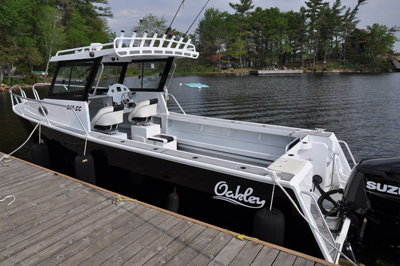 This gives a nice view of the open and generous interior space on the Oakley 245 CC.
This gives a nice view of the open and generous interior space on the Oakley 245 CC.
Oakley already had a fabrication shop including an eight-person team of MIG welders and others with the kind of skills necessary to build welded aluminum boats. Starting a boat company from scratch though, would have been unnecessarily expensive and time-consuming. Instead, he discovered a way to commission the hulls from an established overseas yard the same way as Fleming Yachts, Grand Banks and some other brands do.
Oakley went to a yard that normally builds commercial vessels. They had the resources and experience to do all the design work, destructive testing and other steps necessary for CE certification, US and Canadian Coast Guard certification. An interesting point is that the shipyard had very large sheets of aluminum stock available, so that the whole side of our Oakley test boat was made from one piece of aluminum, cut using a computer-driven waterjet cutter. It takes huge expensive machinery, but this shipyard is accustomed to using it. An interesting point is that our test boat was painted gloss black to show off how smooth and beautifully finished the side of the hull is.
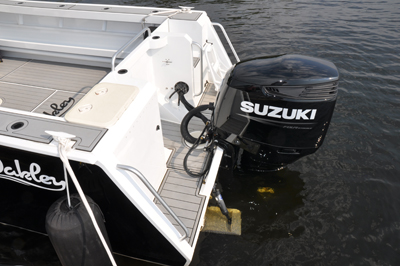 With a starboard side gate and walk through, the swim platform will be quite usable.
With a starboard side gate and walk through, the swim platform will be quite usable.
In this way, Oakley buys the high labour content and expertise from the commercial shipyard for the hulls plus, he can easily change up his designs using their resources. He then receives the complete hull up to the gunwales and his people in Canada go to work completing it.
Oakley boats have four different hulls available and they can complete them in any one of four different configurations here in Canada. The Oakley 245 CC has extensive EVA decking on the topsides from bow to stern and throughout the interior. They get those parts all cut by CNC router and they install the sheet here achieving a considerable saving. The EVA surfaces are hard-wearing, cool, grippy and soft for bare feet. The EVA alsoreduces noise and vibration that can be loud in unfinished aluminum boats.
Our test boat was the 245 CC cuddy cabin model that seems to us, to be an ideal design and layout for Georgian Bay. The 245 CC is 24 feet overall and has an 8-foot 3-inch trailerable beam at the gunwale. If the boat seems a bit high and square, that’s because it is, with a beam of 7-feet 10-inches at the waterline. While the boat draws just 26 inches of water with the motor up, the hull has a maximum depth of 4.75 feet, so it’s a deep boat for its size.
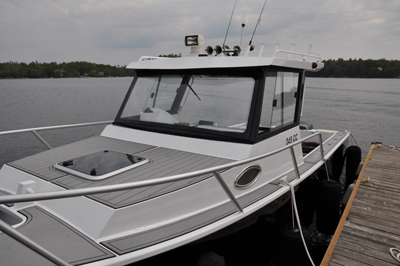 The Oakley 245 CC has a double reverse chine and a very deep 23 degrees of deadrise to really slice through the waves. With its deep freeboard, the 245 CC feels very safe. Where this boat shines is being a safe, dry cottage hauler or fishing boat and it’s perfect for water access Cottagers who often carry lots of people or cargo, sometimes through inclement weather. The beam at the chines translates into stability and that’s an asset for fishing, loading cargo and carrying passengers.
The Oakley 245 CC has a double reverse chine and a very deep 23 degrees of deadrise to really slice through the waves. With its deep freeboard, the 245 CC feels very safe. Where this boat shines is being a safe, dry cottage hauler or fishing boat and it’s perfect for water access Cottagers who often carry lots of people or cargo, sometimes through inclement weather. The beam at the chines translates into stability and that’s an asset for fishing, loading cargo and carrying passengers.
The test boat had a 2021 Suzuki 250 horsepower outboard, but as the builder, Oakley can work with any engine brand a buyer prefers and the 245 CC can be rigged with single or twin engines up to 300 hp. The Suzuki ran great and featured electronic shift and SeaStar steering. The DF 250 has a dual overhead cam powerhead with four valves per cylinder and multi-point sequential electronic fuel injection. Suzuki includes Variable Valve Timing (VVT), which maximises torque in the low/mid-range while a multi-stage induction system maximizes airflow efficiency for top-end performance.
Our readers may not be as familiar with Suzuki engines as some other brands, but Suzuki is sold globally, has comparable features to the top competitors and Suzuki offers a full line of engines right up to 350 horsepower.
Onboard accommodations
It’s all about space for people and cargo. The cuddy cabin is surprisingly spacious and under the hardtop is 6 feet 6 inches of headroom meaning that even a very tall owner is probably going to be comfortable in this boat.
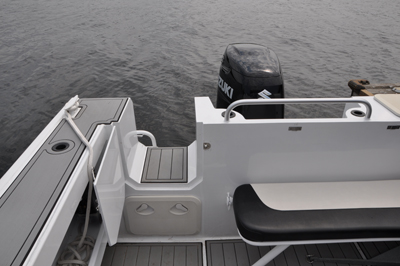 There is a toilet in the centre cuddy cabin area under a cushion and there’s lots of space around it, but our test boat was set up with the cuddy cabin totally open so there was no real privacy for using the head (although a simple curtain could fix that). On the other hand, most Cottagers would prefer the very wide-open access for loading cargo, groceries, luggage and so on.
There is a toilet in the centre cuddy cabin area under a cushion and there’s lots of space around it, but our test boat was set up with the cuddy cabin totally open so there was no real privacy for using the head (although a simple curtain could fix that). On the other hand, most Cottagers would prefer the very wide-open access for loading cargo, groceries, luggage and so on.
Perhaps the main feature for most owners will be the very large and open cockpit. The high sides have a number of advantages. Obviously, it has a lot of freeboard for rough water, but we found that at the docks on Georgian Bay where we were, it was easy to just sit down on the gunwale and swing your legs in. For me as a 6-footer, it was effortless to just stand right up. There was no big step down and if I had been fishing, I would feel very secure leaning against the sides.
An interesting and valuable feature of the Oakley 245 CC is the fact that it has both dual fuel tanks and dual fuel fillers allowing you to select one tank or another to help balance the load or to close off a tank that might have gotten compromised fuel.
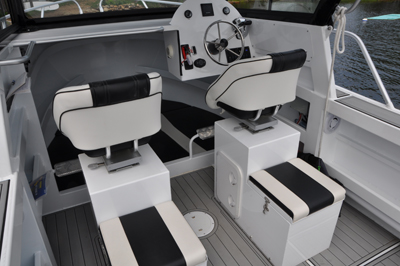 This shows the helm seating and the aft-facing jumpseats. There is storage in the seat bases.
This shows the helm seating and the aft-facing jumpseats. There is storage in the seat bases.
The test boat had no real navigation equipment installed yet, but there’s lots of room for electronics to be installed in the overhead console as well as on the dashboard. We noticed the large aluminum tube that runs the length of the boat from the helm to the transom; it carries all of the wiring resulting in a clean look and greater safety.
We found a substantial underfloor livewell and there are scuppers port and starboard. I thought they looked a bit small until I realized that in the centre was a scupper that has to be a foot wide. You could drain the water out of this boat in no time!
Owners will also appreciate the freshwater washdown system. Just hose ‘er out!
Other features that hint at the boat’s serious commercial construction include the welded aluminum handrails that run up the deck, across the transom and all around the cabin roof. There always seems to be a place you can grab on if need be. There’s a very large deck hatch and that would be my choice for going forward if I was in rough weather and the anchor locker with electric windlass feeds a chute at the bow. Our boat was not yet fitted with its ground tackle system, but the huge anchor locker will hold plenty and it drains out at the chine.
The cabin roof itself is nicely handled with protection from the windshield overhang for the sun and one very large windshield to maximize outward vision. The sliding side glass is versatile; you can open it from the front or the back to suit your need. There are side deck rod holders and a rocket launcher on the cabin roof.
An interesting feature is that the entire cabin roof can be removed by taking out just four large bolts if you wanted to trailer it to a garage. Make no mistake though, this is a tall boat and we loved the 6-foot 6-inch headroom.
The entire boat inside and out, has had the aluminum etched and then painted for a very attractive finish. A buyer could choose to leave the boat in bare aluminum if they wanted something really rugged and low maintenance, but it’s quite attractive this way.
The helm and companion seats were placed high on boxes for good forward vision, have storage inside and there are aft-facing jump seats at the back. The folding aft bench seat can accommodate two or three more. That still left a vast expanse of flat floor for cargo, working a fish, or using removable seating. It’s very versatile. Across the transom is a swim platform with a starboard side walk-through and a great angled set of swim steps.
Performance
The seating position gives a great view in all directions and you sit high with a footrest and the controls in easy reach. The seats adjust for reach. The SeaStar steering has a light, positive feel that made even sharp turns easy and effortless. With the boat trimmed in all the way, it planed off in 5 and a half to 6 seconds, so there’s plenty of power for a load, or towing tubes and the test boat had trim tabs to help in side winds.
Suzuki recommends the best operating range maximum for this motor to be 5,500 to 6,300 RPM and the 4-blade stainless steel prop on the test boat was chosen for fuel-efficiency. That didn’t hamper the acceleration though and we saw a top speed of 41.9 mph at wide-open throttle turning 5,500 RPM.
Normal comfortable cruising at 30 mph has the Suzuki turning a quiet and effortless 4,000 RPM and according to the digital engine readout, we were doing 3.5 miles per gallon which is good.
Overall
The Oakley 245 CC feels like a rough and tumble partner that’s ready to take on anything, alone or with a big gang. The Suzuki 250 is nicely matched and the package should deliver years of safe, comfortable service through just about any weather.
Specifications
Engine: Suzuki DF 250, 4,028 cc, dual cam V6 with 24 valves, EFI, 250 horsepower, stainless steel prop
Performance measured by GPS
RPM SPEED MPH
650 2.7 mph
1,000 5.0
1,500 6.7
2,000 8.5
2,500 11.9
3,000 18.2
3,500 22.1
4,000 29.0
4,500 32.4
5,000 36.1
5,500 41.9 max
Length Overall: 24 ‘ / 7.32 m
Beam: 8 ‘ 3” / 2.53 m
Dry weight (boat and motor): 4,229 lbs / 1,954 kg
Fuel Capacity: 95 gals / 360 L
Price (including trailer, safety gear, freight and Suzuki 250 motor) : $139,000
Test boat and price provided by: Oakley Boats, https://oakleyboats.com






















